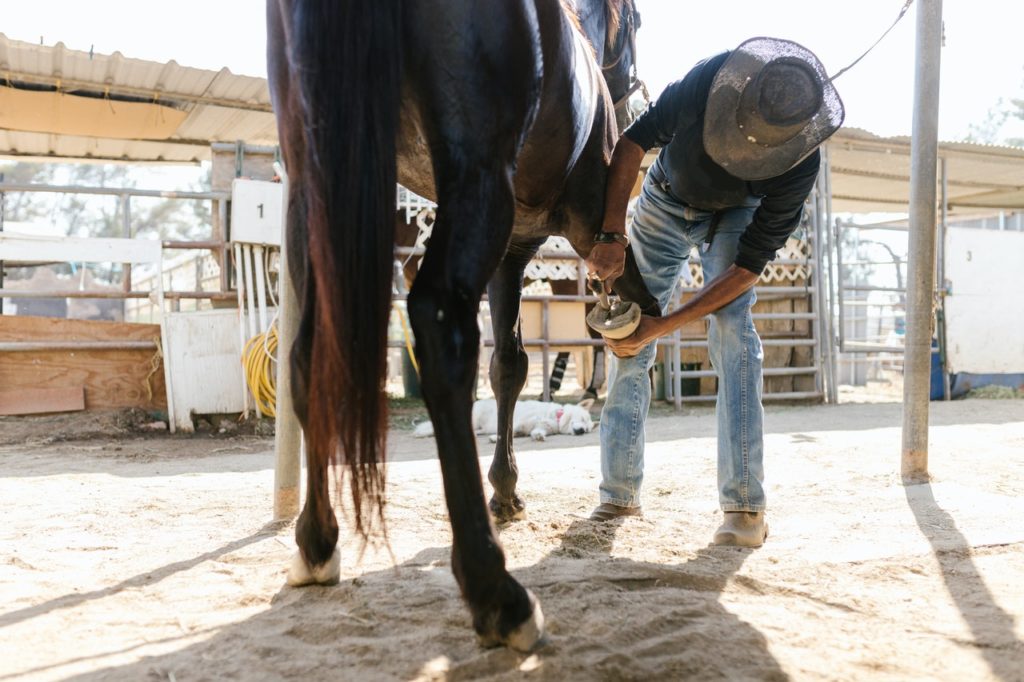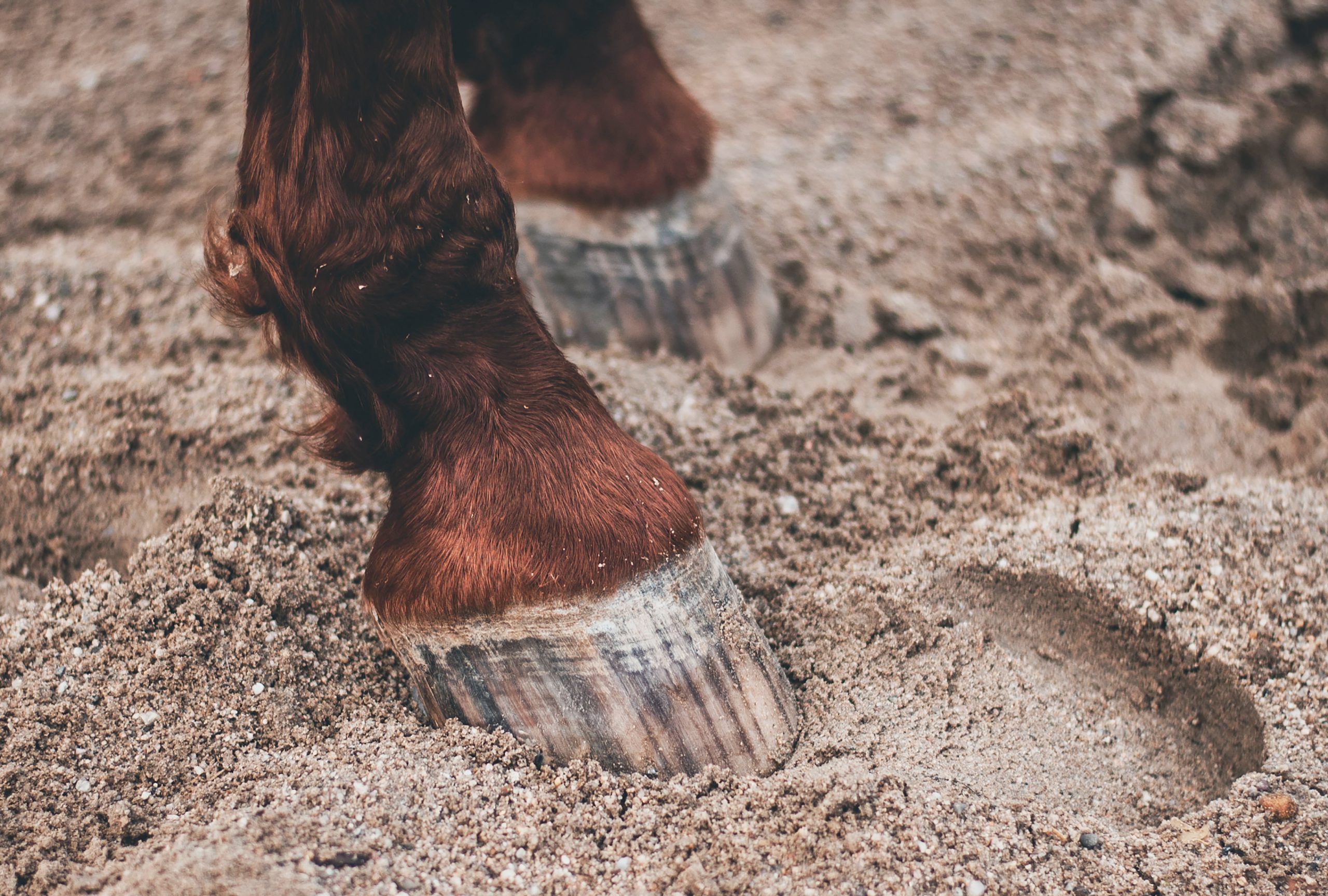
I learned this today. Why do horses need horseshoes? They only need horseshoes if they are going to be walking on hard or rough surfaces for a long time.
The hoof of a horse consists of several different parts. The part that we can see is called the wall. This is up to two centimeters thick, and its job is to protect the inside of the hoof. It is not as solid as it looks. It is flexible because it has to absorb the impact of running and it has to give the horse grip. The wall is similar to our fingernails.
Inside the wall, at the bottom, there is a sole to protect the inside of the hoof. Behind the sole is something called the “frog”. It is called that because it resembles a frog. It is a rubbery structure that performs as a shock absorber and also helps to pump blood back to the horse’s heart. The frog can be likened to our fingertips. Above the frog is a fatty mass called the “digital cushion”. This is another shock absorber. Above this are the bones of the foot and the tendons. The wall of the foot ends in the soft tissue of the leg.
So, why do horses need horseshoes? The number of natural shock absorbers inside the hoof probably give you a good idea. Horses come from the Eurasian Steppes and the plains of America. They evolved to run long distances, but on grass and soft earth. A wild horse can travel up to 50 km a day looking for food and water. When they run on the earth, their hooves act as shock absorbers and give them grip. Their hooves are worn down by the impact with the earth, but they regrow. They grow at a rate of about 2 cm a month. If we had left horses to be wild, they would never need horseshoes.

Humans are said to have domesticated the horse in about 3500 BC, although those horses were not related to the horses that we see today. The ancestor of modern horses was domesticated in about 2200 BC. We domesticated horses because we could ride them, they could carry heavy loads, and we could use them as farm animals. However, until the adoption of the Chinese horse collar into Europe in about the 10th century AD, oxen were still the preferred farm animal.
Once horses were domesticated, they were taken out of their natural environment and made to walk on many different types of surfaces. In the wild, their hooves wear down, but they grow back at a sustainable rate. When horses are used on hard surfaces, such as roads, rocks, or hard dirt, their hooves wear down much faster than they grow back. This exposes the tender inner part of the hoof, and the horse quickly becomes lame. A lame horse cannot be used.
Ancient Asian people very quickly realized that the horse’s hooves wear down too quickly and they made horseshoes out of leather or rawhide. Some people used a leather hoof boot and later some of these were given metal soles. The Romans used something called a hipposandal, which was a metal oval that was tied on to the horse’s hoof with leather laces. The metal oval had grooves to help the horse grip. This is a direct descendant of the modern horseshoe.
In the 5th century AD, the Gauls started to nail on horseshoes with iron nails. The earliest evidence of this was a horseshoe with nails found in the tomb of the Frankish King Childeric I in Belgium. These days, horseshoes are made of many materials. Steel is the most common for working horses, but racehorses use aluminium because it is lighter. Recently, rubber and plastic horseshoes have become more popular because they are more easily molded to the horse’s hoof, and they cushion the hoof much more than metal horseshoes do.
How is a horseshoe applied? A horseshoe is fitted by a farrier. Being a farrier is not an easy job and they have to undergo a four-year apprenticeship before they are licensed. The farrier will start by removing the nails and the old horseshoe. They will make sure the horse’s hooves and feet are healthy and then they will trim back the hoof to fit the new horseshoe. They’ll do that with a file. The farrier will then nail the new shoe to the horse’s hoof by hammering the nails outwards through the wall of the hoof. There are no nerves in this part of the hoof. Depending on the type of work or activity the horse is doing, a new horseshoe will last approximately six weeks.
So, why do horses need horseshoes? Because they evolved to run on grass and soft earth. Their hooves regrow as fast as they wear down in the wild, but they wear down much faster when the horses are working. Horseshoes keep the horses from going lame. And this is what I learned today.
Sources:
https://horseyhooves.com/types-of-horseshoes
https://en.wikipedia.org/wiki/Domestication_of_the_horse
https://en.wikipedia.org/wiki/Horse_hoof
https://en.wikipedia.org/wiki/Hipposandal
https://en.wikipedia.org/wiki/Horseshoe
https://www.mentalfloss.com/article/655903/why-do-horses-need-shoes-cows-dont
https://mtcreekstable.com/2019/03/20/horseshoes-what-exactly-are-their-purpose
https://horseandcountry.tv/why-do-horses-need-shoes-horse-shoeing-guide
https://www.animalfriends.co.uk/horse-and-rider/horse-blog/why-do-horses-need-shoes/
